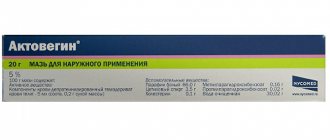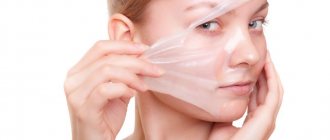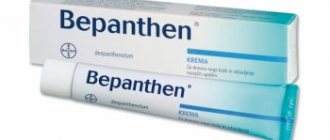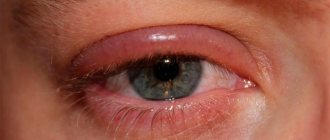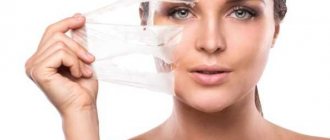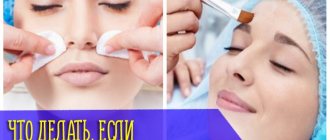The beauties of Ancient Egypt used peeling to cleanse their skin. This word is translated from English as “cleansing, removing the husks.” Cosmetologists call the process during which the top layer of dead cells, along with some living cells, is removed and exfoliated, exfoliation.
As a result, the face returns to youth, attractiveness and a healthy appearance. But in order for beauty to shine faster, the cells that are renewed and work intensively during the period after peeling need to be helped. And this is done with the help of creams and ointments.
What types of peelings are there?
Dead cells are removed by acting on one of three skin levels - this is how peelings differ in depth of penetration.
Superficial, low-traumatic peeling whitens age spots and refreshes the skin without affecting the sensitive layer. Sometimes this type of peeling is used to prepare for cleansing the middle layers of the skin.
The rejuvenating process of medium peeling encourages cell renewal, causes collagen formation and helps lymph flow. Medium peeling is used by girls from 25-27 years old, for which they prepare the skin for the procedure for 2 weeks.
The aggressive deep peeling procedure is compared to plastic surgery, which smoothes out fine and deep wrinkles, eliminates acne marks, scars and evens out the surface of the skin.
Deep peeling, which requires anesthesia, is done using hardware or chemical methods only in a cosmetology clinic.
Recovery after laser treatment
Choosing a cream after laser peeling requires a particularly careful approach. You should select cosmetics that have a healing effect and at the same time prevent the formation of acne or other unwanted side effects. Therefore, Cicalfat from Avene will be a suitable solution. Having a regenerating effect on the skin, it helps to quickly eliminate tissue damage and rejuvenate them. The antibacterial effect will help avoid infectious lesions to which the skin is sensitive after cosmetic procedures.
Why do you need special skin care after peeling?
Peeling procedures end with a painstaking process of restoring the skin surfaces. Sometimes, if you neglect the recommendations given by the cosmetologist, even with complications.
During a peeling session, the skin receives physical and chemical trauma, which is manifested by active peeling, itching and redness.
The weakened tissues of the upper layer become sensitive and susceptible to all kinds of infections. Such skin cannot cope with recovery without special protection in the form of creams and ointments.
What problems will you face after peeling:
- With peeling, the strength of which is influenced by the applied composition;
- With swelling of the nose, neck, décolleté, if the skin is thin and sensitive;
- With the appearance of pimples on problem skin;
- With age spots and freckles, if there is no sun protection;
- With a rash – a manifestation of an allergic reaction;
- With scars or scars, when the crusts are removed independently.
Therefore, it is so important to choose the right care product and remember to apply it.
Doctor's help
The permanent does not always heal correctly. If pathogenic microorganisms enter the blood at any stage of recovery, an infection develops. It is recognized by swelling, redness, pain, and increased temperature. If treatment is delayed, pus will be released from the wounds.
The infection not only spoils the condition, which is already not very good after tattooing. There is a possibility that the drawing will deteriorate because the pigment will take root unevenly. Due to advanced infection, scars form on the skin.
If such symptoms occur, you need to consult a therapist and get tested. Based on their results, the doctor will determine the causative agent of the disease and prescribe the necessary treatment. The faster you begin to get rid of the infection, the less likely it is to develop undesirable consequences.
The body may react negatively to the pigment. If the immune system considers the cells of the dye to be hazardous to health, an allergy will occur. The eyebrows will be very itchy, the skin will become red, swollen, covered in spots or blisters, and begin to peel. There may be difficulty breathing, runny nose, sneezing, itching in the eye area.
Sometimes an allergy occurs not to the paint itself, but to the products used to treat the skin.
If the body reacted negatively to the pigment, it will have to be removed. For this purpose, the laser method, electrocoagulation or cryotherapy is used. The procedure is carried out by a cosmetologist.
What components should be contained in post-peeling products and why?
When choosing post-peeling moisturizers, it is recommended to purchase creams and ointments with substances that help the skin barrier to recover more quickly. In addition, with components that accelerate skin healing and enhance the rebirth of new cells.
And also - with antioxidants.
The basis for cream and ointment should be thermal water.
Cosmetologists advise using the following products:
with hyaluronic and fruit acids;- with amino acids and antioxidants;
- with collagen and alginates;
- with vitamins A, B, C, E, urea and lanolin;
- with natural plant extracts and oils;
- with aloe and algae extracts.
Natural components of medicinal creams and ointments relieve discomfort, moisturize and eliminate tightness. More often, such products are prescribed by a cosmetologist.
Important! You cannot use creams with silicones, parabens and artificial dyes, with fragrances and sodium sulfate laureate, with mineral oil.
General rules and recommendations for the recovery period after peeling
After going through the peeling procedure, the main thing is to moisturize and nourish the injured skin, as well as stimulate regeneration.
In addition to these recommendations, you should definitely adhere to other rules:
- Washing is allowed after 24 hours if the peeling is superficial. Medium peeling imposes such a ban for 3 days and allows only warm acidified water. Deep cleansing allows washing on the 5th day.
- Drying with a towel is not allowed; cosmetic wipes should be used to blot moisture.
- Wash with sulfate-free foams (pH 5) and lubricate the skin with medicated cream or gel.
- On the 5-6th day, apply soothing herbal compresses.
- Do not use alcohol-based products. Purchase anti-inflammatory and bactericidal ointments and creams only in pharmacies.
- Use moisturizing, nourishing creams and alginate masks (made from brown algae).
- Use sunscreen with a UV factor of at least 30.
- Applying makeup is allowed after 14-15 days. The foundation should have an anti-comedogenic effect.
- For two weeks you should not drink alcohol, salty or spicy foods, do not go to the bathhouse or sauna, do not sunbathe, and do not go to sports training.
- To restore hydrobalance, you need to drink clean water - 1.5-2 liters per day.
- If the skin condition worsens, antihistamines and antibiotics are prescribed.
- It is forbidden to use a scrub or forcefully remove a layer of crusts.
If peeling is done by a professional and proper care is taken at home, the skin will recover in a short time and complications will not appear.
Recommendations from cosmetologists
During the recovery period, I recommend to my patients the use of a cream that soothes the skin both after medium peeling and during superficial cleansing. I give preference to professional cosmetics, as they contain additional nutritional components. As for the water-lipid balance, my opinion is that it needs to be restored from the inside by increasing the drinking regime to 3 liters per day.
In my practice, I have repeatedly encountered the presence of highly allergenic components in expensive creams. Therefore, I proceed from the fact that the simpler the composition of the product, the lower the risk of developing unwanted reactions. I prefer monocomponent drugs. For example, Panthenol ointment or a cream with the appropriate name do an excellent job of regenerating the skin after peeling: inexpensive but high-quality care. At the same time, it suits almost everyone and rarely causes intolerance. An alternative option is any analogue with the main active ingredient - panthenol.
It is recommended to care for skin exposed to chemicals based on the strength of the acid’s effect on the epidermis. For surface cleaning, a light emulsion based on panthenol is sufficient. If mid-level cleaning was carried out, the care must be supplemented with a product containing hyaluronic acid. During deep acid procedures, the addition of antibiotics is necessary to prevent the risk of possible infection in the post-peeling period. In the latter case, it is advisable to carry out restoration procedures under the supervision of a specialist.
When can you start using creams and ointments?
After the peeling procedure, swelling, peeling, crusts are visible, the skin begins to heal.
Attention! During this period, it is allowed to use only medicinal creams and ointments with anti-inflammatory and wound-healing properties, which are recommended by a cosmetologist. During the first 7 days, cells actively divide, new fibers are formed, which requires moisture and nutrients. At this stage, it is necessary to use products that help wounds heal, soothe inflammation and soften the skin.
On the 3rd day, apply a moisturizer suitable for your skin type to your face, which is tight with dehydration. After 5-7 days, moisturizing with the help of natural masks and decoctions, and the use of nourishing cream are allowed.
Important! If peeling was done in winter, use a nourishing cream more often than a moisturizer.
Advantages and disadvantages
Coral peeling is valued for its effectiveness, wide possibilities of the technique, safety, and naturalness of the product. The option is popular among cosmetologists and patients. The procedure can be carried out with the participation of a doctor, or independently at home.
Among the disadvantages of coral peeling are:
- painful procedure;
- need for rehabilitation;
- the high cost of a set of medications and a session with a cosmetologist.
In many cases, the intervention option to achieve the goal can be replaced by more comfortable or cheaper procedures. In salon conditions, hardware HydroFashle and diamond microdermabrasion are popular; at home, badyaga and yellow peeling are popular.
Scheme - how to properly apply cream or ointment
In order to quickly revive the skin, when applying a cosmetic product, you should follow these rules:
- Treat the skin with a toner that does not contain alcohol.
- Apply a thin and even layer of cream with gentle, slow movements, moving upwards and to the sides, and also taking into account the direction of the massage lines.
- The product is not rubbed in, but distributed gently with light superficial movements.
- When there are a lot of crusts, the cream is applied 5 times a day. Once the dead skin comes off, two times is enough.
- You will have to use sunscreen or emulsion for 2-3 months before leaving the house.
Carefully! Quick, hasty strokes cause harm to the skin - stretch and injure.
Summary
Proper care after peeling guarantees a woman a good result from the procedure and protects her from complications. Adverse reactions arise not only through the fault of the cosmetologist, but also from how the rehabilitation period goes. It is necessary to strictly follow all the recommendations of the salon master, use all prescribed products and medications and avoid amateur activities. Then exfoliation will be very effective, and the risks of complications will be reduced to zero. Skin glowing with beauty and youth will be a reward for your patience.
TOP 13 creams and ointments for application after peeling
Mandatory care after exfoliation includes the application of moisturizing and soothing creams, the choice of which affects the speed of wound healing and the reduction of discomfort.
D-panthenol
Cream with dexpanthenol or provitamin B5, coenzyme.
Regenerates, heals, and copes with redness and itching in a short time.
Dexpanthenol with vitamin B5
The ointment improves cell metabolism and normalizes protection from external influences.
Compacts collagen fibers and restores tissue and water balance, helps with irritation.
Bepanten
Bepanten ointment is used after damage with medium and deep peeling. The dexpanthenol substance penetrates the tissue, becoming pantothenic acid.
The ointment is useful for accelerating regeneration, healing microcracks and eliminating irritations. Apply a thin layer with light rubbing, first 5 times, then in the morning and evening.
Solcoseryl
Solcoseryl ointment or gel is used after chemical peeling. With blood proteins from calves.
Helps saturate cells with oxygen and produce collagen, enhancing regeneration and accelerating healing. Reduces swelling and inflammation. For post-peeling care and complications with burns.
Vegefarma Cream
Vegefarma Cream is used after laser and chemical peeling. Contains rapeseed and sunflower oil, milk proteins, chamomile and fireweed flower extracts.
Antibacterial, fights inflammation, moisturizes. Used to prevent infections. Relieves redness and irritation.
Baby cream
Regular children's cream for use after superficial and medium peeling 7-10 days after the procedure.
With plant extracts and oils, natural animal fats, beeswax, silicon dioxide, kaolin and other substances. Nourishes, moisturizes, helps protect the skin during sudden temperature changes.
Traumeel
The ointment contains calendula and witch hazel, echinacea and yarrow, chamomile and daisy, arnica, St. John's wort and belladonna.
Anesthetizes, relieves inflammation, irritation and discomfort. Removes swelling with redness. Corrects complications.
Methyluracil
Methyluracil ointment is used after deep peeling or if complications arise. Protects the skin from ultraviolet radiation, promotes healing by accelerating cell regeneration. Relieves inflammation.
Hydrocortisone ointment
Hydrocortisone ointment for treatment after skin trauma by medium and deep peeling. With the hormone hydrocortisone, lanolin, pentol and stearic acid.
After applying the ointment, the skin does not itch, redness and swelling disappear. Antiallergenic agent.
Christina
Protective cream Christina with zinc oxide, shea butter, rosehip and jojoba. With carnauba wax, red clay, alaria extract, vitamins A and E and bisabolol.
Regenerates cells, protects against UV rays, eliminates rashes on oily skin. For a tonal effect. Apply to problem skin of oily and dry type.
Terra mater
Terra mater cream is used after acid peeling and mechanical cleaning. Contains centela asiatica, collagen and vitamin complex.
Moisturizes, gives calm, after which redness and acne disappear, the skin heals faster. Easily spread over cleansed skin and wait 5 minutes.
Bioderma sensibio forte
Bioderma sensibio forte (Sensibio Forte) is useful after laser peeling. With vitamin A and active natural substances.
Hypoallergenic, moisturizing, relieving irritation and inflammation. Apply day and evening to sensitive skin in case of irritation.
La Roche-Posay Hydreane
Composition of moisturizing cream for dry and very dry skin “La Roche-Posay Hydreane” with hydrolipids and glycerin, black currant oil, apricot kernels, coriander and thermal water enriched with selenium. Contains karite butter and bio oils.
Soothes, nourishes and moisturizes. Restores tissue. For dry skin, apply to face and neck twice daily.
When do you need additional SPF and how to choose it?
Sunscreen is applied to prevent pigmentation before leaving the house, because ultraviolet radiation passes through even dense clouds.
To protect the skin, a product with SPF 50 is suitable, which means that only 1% of the rays will reach the skin. This cream is used for another 2 months after the skin has healed.
3 products with SPF suitable for facial skin after peeling
The sunscreen SPF 50 “Sublime Sun” (L'Oreal Paris) contains jasmine extract and vitamin E. The product moisturizes and rejuvenates the skin, prevents the synthesis of melanin, which inhibits the appearance of hyperpigmentation.
Anti-aging cream “Medium Holy Land Age Defense” (CC Cream SPF50) consists of gingko biloba extract, vitamins E, C, citric acid, including green tea leaves. These substances accelerate regeneration, cope with inflammation and redness.
Anthelios La Roche-Posay cream is recommended for those with sensitive and irritated skin. The product reliably protects against ultraviolet radiation and softens fabrics.
How to deal with complications?
Unfortunately, exfoliation can bring not only smooth, glowing skin, but also scarring, acne, hyperpigmentation, and worsened cold sores.
Pigmentation is a rather unpleasant side effect of laser exfoliation and TCA. To prevent this, treat your face with kojic and retinoic acids before exfoliation. Some post-peeling treatments also remove subsequent pigmentation. This is the application of acetylcysteine and strong antioxidants (tocopherol, ascorbic acid, silene, etc.) to the epidermis.
Exacerbation of herpes may occur in those individuals who note this phenomenon at least twice a year. To prevent foci of herpes from spreading across the face after scrubbing or peeling the face, it is necessary to carry out appropriate therapy: take antiviral medications: oral medications and ointments.
If a woman is prone to acne, after exfoliation it may appear in an aggravated form. Agents with anti-inflammatory and sebostatic properties will be required. Antiseptic preparations with zinc can be applied pointwise to pimples and blackheads.
Severe peeling of the skin can also be observed after medium or deep exfoliation. There is no need to take any measures, the skin should exfoliate on its own. How to exfoliate skin faster after peeling? Cosmetologists strongly recommend: do not comb, do not pick off scales and do not use scrubs. All these manipulations can lead to scar formation.



